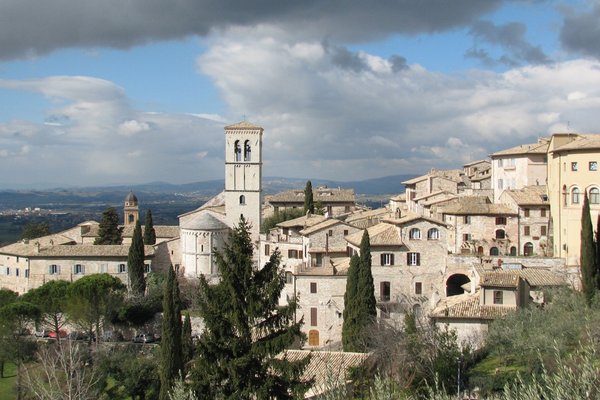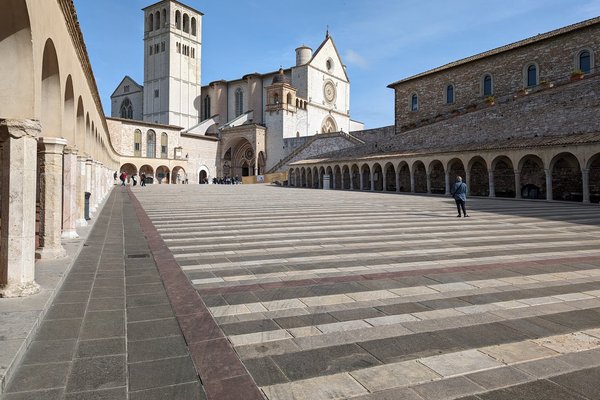Italy
Assisi
Assisi, the Basilica of San Francesco and Other Franciscan Sites comprise a hill town and sanctuary, from where the Franciscan movement spread across the world from the 13th century.
Assisi was the birthplace of Saint Francis, the founder of the Franciscan Order. The medieval town holds many Franciscan religious buildings, of which the Basilica of San Francesco is renowned for its art - notably paintings by Cimabue and Giotto.
Community Perspective: Visited by both pilgrims and tourists in large numbers, they come here as much for the religious relics as for the picturesque setting and the aperol spritz. The San Francesco Basilica, with its fine frescoes and paintings, is the one building interior not to miss. Matejicek has highlighted some of the other included Franciscan sites.
Site Info
Official Information
- Full Name
- Assisi, the Basilica of San Francesco and Other Franciscan Sites (ID: 990)
- Country
- Italy
- Status
-
Inscribed 2000
Site history
History of Assisi
- 2000: Inscribed
- Inscribed
- 1996: Revision
- Reduced from former TWHS Assisi and Cortona
- Type
- Cultural
- Criteria
- i
- ii
- iii
- iv
- vi
Links
- UNESCO
- whc.unesco.org
- Official
-
- sanfrancescoassisi.org — Basilica
- Related
-
- assisionline.com — Assisi online
- sacredsites.com — Link
All Links
UNESCO.org
- whc.unesco.org — whc.unesco.org/
Official Website
- sanfrancescoassisi.org — Basilica
Related Resources
- assisionline.com — Assisi online
- sacredsites.com — Link
Community Information
- Community Category
- Religious structure: Christian
- Urban landscape: Medieval European
Travel Information
Undergoing Restoration or Repair
Rome hotspot
Recent Connections
-
Rose garden
To the right of the apse of the basilic…
-
Perfect Inscriptions
2000 -
Griffins
The three portals of the Cathedral of A…
Connections of Assisi
- Individual People
-
-
Frederick II
Emperor Frederick II was (allegedly) baptised in Assisi Cathedral. (Nomination file, p. 19) -
Goethe
Temple of Minerva: "The temple was visited and described by the German poet Goethe during his travels in Italy, as the first ancient structure in good condition seen during his life (1786)."See en.wikipedia.org
-
Mapped or Illustrated by Blaeu
See artisanmaps.com
-
Giotto
"Its medieval art masterpieces, such as the Basilica of San Francesco and paintings by Cimabue, Pietro Lorenzetti, Simone Martini and Giotto, have made Assisi a fundamental reference point for the development of Italian and European art and architecture." (Official description) - The nave of the Upper Basilica of Saint Francis is dominated by the fresco cycle attributed to Giotto: 28 episodes of the life of Saint Francis. (Nomination file, p. 18) - "From 1306 from 1311 Giotto was in Assisi, where he painted the frescoes in the transept area of the Lower Church of the Basilica of St. Francis, including The Life of Christ, Franciscan Allegories and the Magdalene Chapel".See en.wikipedia.org
-
Simone Martini
The San Martino Chapel in the lower church of the Basilica of San Francesco d'Assisi features frescoes by Martini.See en.wikipedia.org
-
Frederick Barbarossa
After a period of wars, in 1174 Assisi was besieged and conquered by Frederick Barbarossa, who gave the investiture of the city to Duke Conrad of Lutzen, also known as Conrad of Urslingen: Assisi became an imperial dominion.See it.wikipedia.org
-
- Trivia
-
-
Opera
Saint Francois d'Assise by Messiaen (1983) Tableau 6 - Hermitage of the Carceri Tableau 8 - Church of the Porziuncola -
Fatal Accidents or 'disasters'
"On the morning of September 26, 1997, two earthquakes hit the region around Assisi in rapid succession(...). There was widespread devastation and many ancient buildings were destroyed or damaged. While a group of specialists and friars were inspecting the damage to the Basilica of Saint Francis, an aftershock shook the building, causing the collapse of the vault. Two Franciscan friars who were among the group and two of the specialists were killed. (...) The collapse was captured on tape."See en.wikipedia.org
-
- History
-
-
Sieges and Battles
After a period of wars, in 1174 Assisi was besieged and conquered by Frederick Barbarossa.See it.wikipedia.org
-
Knights Templar
Inside the church of San Pietro, there is the seal of the Templars, on the right wall of the church in the passage that leads to the crypt; it is a six-petalled flower (flower of life).See it.wikipedia.org
-
Places of Execution
The place where the Basilica of Saint Francis was built was known as the "Hill of Hell", because it was used for the execution of condemned criminals. After the construction of the Basilica, its name changed in the "Hill of Paradise". "St. Francis wanted to be buried at this location outside of Assisi's city walls, called Hill of Hell (Collo d'Inferno - here were the gallows where criminals were put to death), because his master Jesus of Nazareth also was killed like a criminal outside of the city of Jerusalem." (Nomination file, p. 13)See en.wikipedia.org
-
Birthplaces
"Assisi, developed in ancient Roman times achieving importance, in part, as a religious and spiritual centre. It continues that role into the present with its association with the birth and life of Saint Francis (1182-1226) and development of the Franciscan Order since the 13th century". (Official description) -
Medici
On the left side of the basilica of Santa Maria degli Angeli is the Fontana delle ventisei cannelle commissioned by the Medici family of Florence and which is decorated with their coat of arms. There was already an aqueduct built by Cosimo il Vecchio, then renovated by Lorenzo il Magnifico in 1486 for the use of convent. (Nomination file, p. 44) -
Popes
Basilica of San Francesco: "On 16 July 1228, Francis was canonized by Pope Gregory IX in Assisi, and he laid the foundation stone of the new church the following day, although construction may already have been begun. The construction having been begun at his order, the Pope declared the church to be the property of the papacy."See en.wikipedia.org
-
Roman monuments converted into churches
Santa Maria della Minerva: "The Roman temple, traditionally dedicated to Minerva, or possibly to Castor and Pollux, is relatively well preserved. It was first converted into a church and then, in 1212, into a prison. From 1456 the building was again used as a church, dedicated to Santa Maria della Minerva in 1539." (AB Ev)See en.wikipedia.org
-
- Ecology
-
-
Notable Trees
The monumental holm oaks of the Eremo delle Carceri are monumental trees located within the Monte Subasio Park. Holm oak N° l is located nearby of the so-called Grotta di San Francesco. A sign at the height of the specimen indicates that this is a «Tree from the time of Saint Francis», from which a secular age of 850-1,000 years is estimated, since Francis lived from 1181 to 1226.
-
- Architecture
-
-
Carrara marble
The statue depicting Saint Rufinus of Assisi In the right nave of the Cathedral of San Rufino is a work sculpted in Carrara marble by the Frenchman Paul Lemoyne in 1823.See it.wikipedia.org
-
Gothic
Basilica of San Francesco: "(...) the upper building is conceived as a vast Gothic hall, to represent the life of the saint." "The lower basilica of San Francesco is entered through an exquisite Gothic portal" (AB Ev) Other Gothic buildings include the Basilica di Santa Chiara and the Sacro Convento.See en.wikipedia.org
-
Romanesque
Basilica of San Francesco: "The lower level contains a church with imposing Romanesque arches, dedicated to the cult of the saint (...)." - Cathedral of San Rufino: "The west front is a masterpiece of Umbrian Romanesque architecture (...)." (AB Ev) Other Romanesque buildings include San Damiano, Santo Stefano, the Abbey of Saint Peter and Santa Maria Maggiore.See en.wikipedia.org
-
Designed by Galeazzo Alessi
Sta Maria degli Angeli -
Renaissance
"the Renaissance fort of Rocca Maggiore", "the Renaissance monastery and basilica of Santa Maria degli Angeli" (AB Ev) -
Rose garden
To the right of the apse of the basilica of Santa Maria degli Angeli, there is the rose garden. This place is famous for an event that involved Saint Francis: one night, the Saint, overcome by strong doubts and remorse for sin, rolled over naked in the thorny rose garden. According to tradition, this rose garden lost all its thorns upon contact with the body of the Saint so as not to cause any damage. Even today the rose garden blooms without thorns. (Wikipedia)
-
Grotesques
The vault located under the Palazzo dei Priori is decorated with grotesques, painted in 1556 by a "Raphael Pictor" on the order of the Governor Marcello Tuto. (Nomination file, p. 31) -
Mosaic art
"From the crypt of the original cathedral of Santa Maria Maggiore you descend to an underground environment that corresponds to a Roman house dating back to the first century. AD. Excavations made in the nineteenth century and in the 50s of the twentieth century have unearthed three adjoining rooms and a cryptoporticus, with floors covered with mosaics (...)." -
Baroque
The temple of Minerva "currently houses a church, Santa Maria sopra Minerva, built in 1539 and renovated in Baroque style in the 17th century."See en.wikipedia.org
-
Brick architecture
Chiesa NuovaSee it.wikipedia.org
-
Gothic Revival
The church (and part of the convent) of the Sanctuary of Rivotorto was rebuilt in neo-Gothic style between 1860 and 1880, after the violent earthquake of 12 February 1854 had razed it to the ground.See it.wikipedia.org
-
Domes
The dome of the basilica of Santa Maria degli Angeli (Nomination file, p. 6, 44)See en.wikipedia.org
-
- Damaged
-
-
Destroyed or damaged by Earthquake
1997 earthquake
-
- World Heritage Process
-
-
Cultural landscape not recognized
Both the official description and the AB Ev refer to Assisi as a cultural landscape. "Assisi represents a unique example of continuity of a city-sanctuary within its environmental setting from its Umbrian-Roman and medieval origins to the present, represented in the cultural landscape, the religious ensembles, systems of communication, and traditional land-use. (Criterion iii - Official description) – "The territory forms a cultural landscape with natural and human elements, such as settlements, religious ensembles, road systems, traditional systems of cultivation, and agricultural management structures." "Assisi and its built territory represent an outstanding example of an Umbrian hill town and cultural landscape that has maintained its historical stratigraphy since antiquity." (AB Ev) -
Reduced from broader TWHS
TWHS originally included the work of Fra Angelico in Cortona. -
Perfect Inscriptions
2000
-
- Religion and Belief
-
-
Female Christian Mystics
Saint Clare was born in Assisi. "As a teen, she heard Francis preach during a Lenten service in the church of San Giorgio at Assisi. Inspired by his words and knowing that marriage was rapidly approaching, Clare went to Francis and asked him to help her to live after the manner of the Gospel." Clare and her sister Agnes "remained with the Benedictines until a small dwelling was built for them next to the church of San Damiano, which Francis had repaired some years earlier. (...) Other women joined the sisters (...) San Damiano became the centre of Clare's new religious order, which was known in her lifetime as the "Order of Poor Ladies of San Damiano". (...) By 1263, just ten years after Clare's death, the order had become known as the Order of Saint Clare."See en.wikipedia.org
-
Legends and Folk Myths
Santo Stefano: "According to a Franciscan tradition, the bells of the ancient church were heard to ring of their own accord at the moment of the death of St. Francis, which occurred at the hour of Vespers on October 3, 1226." (Nomination file, p. 24)See en.wikipedia.org
-
Cathedrals
San Rufinus -
Franciscan Order
"Being the birthplace of the Franciscan Order, Assisi has from the Middle Ages been closely associated with the cult and diffusion of the Franciscan movement in the world, focusing on the universal message of peace and tolerance even to other religions or beliefs." (Official description) -
Hercules
Temple of Minerva: "The attribution to the goddess Minerva derives from the finding of a female statue, although a dedication stone to Hercules has been found, and the temple was likely dedicated to this male demi-god."See en.wikipedia.org
-
Goddesses
Temple of Minerva (AB Ev) (Nomination file, p. 41) – "The attribution to the goddess Minerva derives from the finding of a female statue".See en.wikipedia.org
-
Christian Pilgrimage Sites
St. Francis of Assisi and St Clare, relics -
Religious Relics
At Santa Chiara: "Against the back wall of the crypt are some holy relics, including tunics worn by Francis and Clare, a shirt she embroidered, and some locks of hair Francis sheared from her head." – The Basilica of San Francesco holds the remains of Saint Francis in the crypt in the Lower Church.See en.wikipedia.org
-
Saints' Caves
St Francis - At the heart of the Eremo della Carceri is the cave which St Francis used as a retreat -
Cistercian
"Originally built outside the city walls, the Benedictine abbey of San Pietro is recorded from 1029; in the middle of the 12th century it adopted the Cluny reform and it passed later to the Cistercians." (AB Ev) -
Beatified Persons
Blessed Giles of Assisi (c. 1190-1262 – Beatified in 1777) "was one of the original companions of Francis of Assisi and holds a leading place among them."See en.wikipedia.org
-
Benedictines
the Benedictine abbey of Saint Peter (San Pietro) (AB Ev) – San Pietro was built by the Benedictines in the tenth century, the building was remodelled several times until the definitive reconstruction which dates back to the thirteenth century, with characteristic signs of the Benedictine Order.See it.wikipedia.org
-
Griffins
The three portals of the Cathedral of Assisi are flanked by lions and griffins. (Nomination file, p. 19)
-
- Human Activity
-
-
Festivals
The Calendimaggio of Assisi is a festival that is celebrated every first Wednesday, Thursday, Friday and Saturday after May 1st of every year, to welcome the arrival of spring. The two Parties into which the city is divided, the Nobilissima Parte de Sopra and the Magnifica Parte de Sotto, challenge each other to win the palio, through the holding of processions in medieval costumes, re-enactments of medieval life in the city's alleys and musical performances. The Town Hall square (Piazza del Comune) is the centre of the event.See it.wikipedia.org
-
Man-made Terraces
Roman city plan (which is still intact) was based on terraces -
Brothels
The vault located under the Palazzo dei Priori is commonly called "Volta pinta" and provided access at the communal brothel, documented since the 14th century. In 1453, it was decided, for greater decorum, to close the back part; the premises were then used for the grain trade. (Nomination file, p. 31) -
Frescoes or murals by famous painters
Cimabue, Giotto, Simone Martini and Pietro Lorenzetti; Santa Maria degli Angeli: Johann Friedrich Overback and Pietro Perugino -
Historical Graffiti
"From the crypt of the original cathedral of Santa Maria Maggiore you descend to an underground environment that corresponds to a Roman house dating back to the first century. AD. (...) On the walls are engraved numerous graffiti with poetic verses, one of which names a Musae domus; hence the attribution to the muse of poetry and the house belonging to the poet Properzio. But the lack of archaeological and historical evidence is inadequate with the certainty to endorse this hypothesis."
-
- Constructions
-
-
Cryptoporticus
"From the crypt of the original cathedral of Santa Maria Maggiore you descend to an underground environment that corresponds to a Roman house dating back to the first century. AD. Excavations made in the nineteenth century and in the 50s of the twentieth century have unearthed three adjoining rooms and a cryptoporticus, with floors covered with mosaics (...)." -
Walled cities
-
Hospitals
Monte Frumentario Palace was the old hospital of the community, and one of the first public hospitals built in Italy. (Nomination file, p. 31) -
Cisterns
"The remains of the Forum include the base of the temple with the access doors to the vestibule, a monumental cistern, a podium with the seats for the judiciary, and a small tetrastyle temple dedicated to Castor and Pollux." -
Cemeteries
Through a door in the Chapel of Sant'Antonio (also called the Chapel of the Sacrament) in the Lower Basilica you pass to the small cloister of the Cemetery of the friars; the floor and walls of the portico are covered with tombstones, the oldest of which dates back to 1295.See it.wikipedia.org
-
Clock Tower
The clock tower of the Cathedral of Assisi: "One can see on the bell tower a colossal one-handed liturgical clock showing the 24 hours of the hora italica (Italian time), a period of time ending with sunset at 24 hours." (wiki) -
Prison
Santa Maria della Minerva: "The Roman temple (...) is relatively well preserved. It was first converted into a church and then, in 1212, into a prison. From 1456 the building was again used as a church (...)." (AB Ev) -
Loggia
Basilica of San Francesco: Loggia delle BenedizioniSee it.wikipedia.org
-
Tombs
The tomb of saint Francis in the crypt of the Basilica of Saint Francis of Assisi (Nomination file, p. 15)See en.wikipedia.org
-
Tower-houses
"(...) profound changes from the 11th and 12th centuries (...) A series of castles were built on the margins of the valley, and others were developed as centres of pastoral culture in the mountain region. In addition, there were new rural settlements, including the characteristic Umbrian building type of tower house, which remains a feature of all Assisi iconography until the present day." (AB Ev) -
Unfinished constructions
Santa Maria degli Angeli: In 1685, one of the two planned campaniles was completed and the church took its final form since the other one will never be built. (Nomination file, p. 44) -
Freestanding Bell Tower
Basilica of San Francesco: "To the left of the church stands a free-standing bell tower of Romanesque design."See en.wikipedia.org
-
Roman amphitheatres
"the remains of the ancient amphitheatre" (AB Ev) – Roman amphitheatre: dating back to the first half of the 1st century AD, it is located at the end of the piazza Matteotti, outside the ancient city walls. (Nomination file, p. 43) -
Monumental Fountains
Fonte Oliviera (Nomination file, p. 39)
-
- WHS on Other Lists
-
-
INTO Places Program
Bosco di San FrancescoSee fondoambiente.it
-
- Timeline
-
-
Built in the 13th century
foundation of the order
-
- WHS Hotspots
-
-
Rome hotspot
2.5h-3h train
-
- Science and Technology
-
-
Libraries
The library of the Sacro Convento, opened to the public in 1979, not only holds documents from the convent, but also the old collection of the municipal library, with the manuscripts dating from before the 19th century. It has 709 handwritten codes (12th-16th centuries), many of which present splendid illuminations, 356 incunabula, 3,256 "cinquecentine" and more than 92,000 volumes. Particularly interesting is the musical collection, which includes around 2,500 manuscripts. (Nomination file, p. 37)See it.wikipedia.org
-
- Visiting conditions
-
-
Undergoing Restoration or Repair
There is restoration work in progress in the Basilica of Santa Maria degli Angeli. The Transit Chapel is not accessible and cannot be visited. The works started in May 2023 and are projected to take 14 months. An information table in the church states everything should be finished by September 2024. (Website) Apart from that, the Santuary of Rivotorto is also closed for works. Their website doesn't state any end date.
-
- WHS Names
-
-
Named after a local Christian saint
Saint Francis of Assisi, (Feast Day: October 4) was born, lived, and is buried on this site.
-
- Literature & Film
-
-
Location for a classic movie
Some scenes of the film "Brother Sun, Sister Moon" from 1972, directed by Franco Zeffirelli, were filmed inside the Sacro Convento. The film won the David di Donatello Award for Best Director and was nominated for an Oscar for Best Art Direction.See it.wikipedia.org
-
News
No news.
Recent Visitors
Visitors of Assisi
- 4lex
- Albert
- Alberto Rodriguez Gutierrez
- Alexander Barabanov
- Alexander Lehmann
- Alexander Parsons
- Alex Goh
- Ali Zingstra
- ALS
- Alvaro1404
- Ammon Watkins
- Ana
- AndreaTLV
- Anna Wludarska
- Argo
- Artur Anuszewski
- Aspasia
- Astraftis
- Atila Ege
- awestix
- AYB
- Badwater
- Bamse
- BaziFettehenne
- bergecn
- bethready
- Bill Maurmann
- Bin
- Bodil Ankerly
- bossc
- Brendan Carroll
- butterflybird
- Caspar
- CeeMon
- Cezar Grozavu
- Chantal den Haan
- chenqtao
- Cheryl
- CherylKla
- Christian Wagner
- Christravelblog
- Claire Bradshaw
- Cluckily
- Clyde
- Cobaltrage
- Col
- cophbulls
- Cristina Erba
- Csaba Nováczky
- CugelVance
- Cyberczar
- Damientournay
- Dani Cyr
- Daniela Hohmann
- Dan Pettigrew
- David Aaronson
- David Berlanda
- David Marton
- Dimitar Krastev
- Dimitrios Polychronopoulos
- DL
- Dorejd
- Doubanjiang
- DouglasR
- Dr. Caligari
- Eirini
- Elia Vettorato
- eljx1988
- Els Slots
- Erfe91
- Eric Lurio
- Errol Neo
- Eva Kisgyorgy
- Evgenii
- Fan Yibo
- Farinelli
- Federico P.
- Felicité
- Fernweh
- Filip Murlak
- Fmaiolo@yahoo.com
- Frederik Dawson
- Geo.Mav
- George Gdanski
- GeorgeIng61
- Gernot
- Giannis75
- giulio25
- grimloch
- Hadrianus
- HaraldOest
- Harry Mitsidis
- Hasco
- H Beswick
- Hubert
- Iain Jackson
- Ilya Burlak
- Ivan
- Ivan Rucek
- ivantham
- Jaakkotoivanen
- Jakob F.
- janem
- Janina Lehmann
- janis
- Jan Korpeg
- Jarek Pokrzywnicki
- Javier Coro
- Jawnbeary
- jcleek27
- Jeanne OGrady
- Jens
- Jezza
- Jgriffindor6
- JL
- João Aender
- Joel on the Road
- Jonas Kremer
- Jon Eshuijs
- Jonoprout
- Joyce van Soest
- JR's HERITAGE SITES
- Jurre
- KarenBMoore
- Karito Vies
- KeithBailey
- Ken DJ
- Kjlauer
- Klara Woodson
- Klaus Freisinger
- Knut
- Krijn
- Krzysztof B
- Kurt Lauer
- La Concy
- Lara Adler
- LaVale
- Liamps91
- lindaann
- Linz
- Lisu Marian
- Loic Pedras
- Luboang
- Lucio
- Ludvan
- Luis Filipe Gaspar
- lynnz317@aol.com
- Maciej Gil
- Maciej Gowin
- marcel staron
- Martin
- Martina Rúčková
- maryhattie
- Matejicek
- Mateusz
- Matthewsharris
- MAURO PODDA PANI
- MaxHeAnouBen
- MaYumin
- Mia esguerra
- MichaelH
- Michael Novins
- Michael Turtle
- Mikan22
- Mikko
- Milan Jirasek
- MMM
- Monica Tasciotti
- Morodhi
- MRZVA
- nan
- napalm
- Nihal Ege
- nikolamus
- NoahFranc
- opperpco3
- PabloNorte
- Paola Laura
- Patrik
- Paul Schofield
- PeterH
- Peter Lööv
- Petteri
- Philipp Leu
- Philipp Peterer
- phillipmeng
- Piotr Wasil
- pontobaggins
- Purrfect
- Rafał Kałczuga
- Ralf Regele
- Randi Thomsen
- Reisedachs
- Remigiusz
- Reza
- Riccardo Quaranta
- Rick Ohm
- RJPTravel
- RobRos
- Roccobot
- Roel Sterken
- Roger Ourset
- Roman Bruehwiler
- Sabrina Liebehentschel
- Samy G
- sbshipway
- Sclowitz
- Sebasfhb
- Sergio Arjona
- Shandos Cleaver
- Shannon O'Donnell
- sime147
- SirLoydd
- Solivagant
- Sorel Americo
- Stanislaw Warwas
- stephanvermeulen
- Stijn
- Svein Elias
- SymonMajewski
- Szabolcs Mosonyi
- Szabo Viktoria
- Szucs Tamas
- Tamara Ratz
- Tammy Gouldstone
- Taotao Chen
- Tarquinio_Superbo
- thisispivi
- Thomas Buechler
- Thomas van der Walt
- Thorben
- Tim Allen
- TimPick
- Tom Flaten
- tommasorossotti
- tony0001
- triath
- Tsunami
- usagi1974
- ValiaVeweth
- Vanessa Buechler
- Van Hung
- Vernon Prieto
- Viaje al Patrimonio
- vino4vino
- V&M
- Walter
- Wieland
- WILLIAM RICH
- Wimmy
- Wojciech Fedoruk
- Xander Huang
- Xiong Wei
- Xiquinho Silva
- YaroMir
- Yevhen Ivanovych
- Yongcheng Liu
- Zoë Sheng
Community Reviews
Show full reviews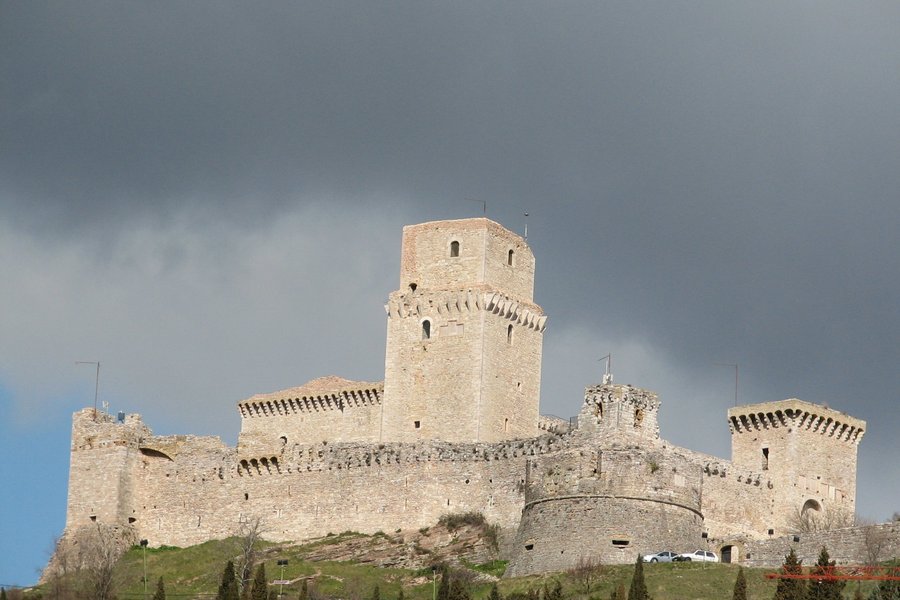
I grew up on the stories of St. Francis of Assisi and was always drawn to him as an example of how to cherish and care for nature as well as human beings. Because of this, there was a deep sense of power and peace when I finally visited the basilica, which is one of the most beautiful and unique I have ever experienced. It was incredibly moving to visit the Saint's grave, and I was surprised to learn that the basilica is, in effect, 2 churches built n top of one another, each with their own unique architectural and artistic beauty to appreciate. This was one of those sites that not only lived up to my hopes and expectations, but exceeded them. The town itself is also a lovely walk after you are finished in the church, with wonderful local eateries to enjoy.
Keep reading 0 comments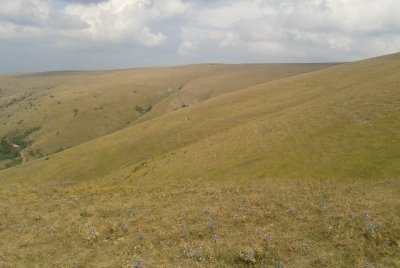
Visited 3-times:
-as regular tourist spending few hours in Assisi only: it means running from parking lot close to S. Chiara towards the basilica S Francesco, being half an hour inside the basilica, having the rest for an hour to enjoy apperol spritz at Piazza del Comune Assisi, etc...
-as independent traveller accommodated close to Santa Maria degli Angeli for 3 days. It was sufficient to visit (almost) all important franciscan sites in/around Assisi: (1) Basilica di S Maria degli Angeli (huge 16th-century basilica with original church of Porziuncola inside - an important place in life and death of S Francesco), (2) City of Assisi with the Basilica of S Francesco (amazing church with three parts - described in detail by others), There are many important historical monuments within the city walls as described by others, I would emhasize the facade of cathedral S Rufino (important masterpiece of Umbrian romanesque style, interesting to compare with facade of Duomo in Spoleto), (3) S Damiano outside city walls (very quiet place, also important in life of S Francesco), (4) Eremo di Carceri (located in the area of Mt Subasio, it takes some effort to climb the mountain but one can feel Franciscan spirituality there), (5) Santuario di Rivotorto - I have not visited it, but it is not far from Santa Maria degli Angeli by public transport. It is another place where early franciscan comunity lived for certain time, before moving to Porziuncola.
Photo: upper parts of Monte Subasio …
Keep reading 0 comments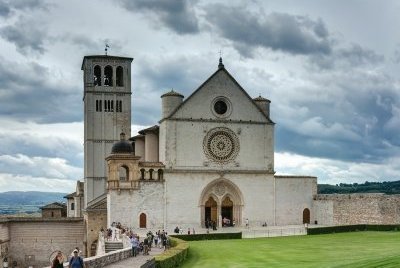
I visited Assisi in the summer of 2014. At that point, the town easily vaulted towards the top of my personal list of the most impressive day-trip destinations, having hosted us for half of a day. The town’s World Heritage inscription is centered on its sacred architecture, but it is also incredibly picturesque and, pilgrimages aside, does not convey a feeling of being overrun with tourists. Although there are plenty of crafts, souvenir, and local specialty shops, Assisi does not feel overly commercialized either. There is a number of fairly interesting museums sprinkled around the town, all seemingly not requiring any fee to enter. But the pilgrims and most of the tourists come to Assisi for its religious monuments.
Basilica of St. Francis, the monumental church honoring the most famous local son is a magnificent architectural masterpiece. It is actually two basilicas in one. The lower basilica, with un-church-like low ceilings, is covered all over in brilliant frescoes and paintings. The upper basilica, more traditional in form, is also vibrantly decorated. I have seen my share of spectacular cathedrals but San Francesco is a species apart, in my experience.
We also visited the other major churches named in the UNESCO inscription, Santa Chiara, San Ruffino, Santa Maria sopra Minerva. Each one has something to impress with and warrants a look, but they pale in comparison to San Francesco. Beyond that, we simply leisurely strolled through the town. Its terrace-based hillside plan makes it less compact than other destinations …
Keep reading 0 comments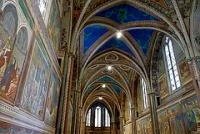
I visited this WHS in August 2013. Compared to what I've read I was surprised that I was one of the few tourists around (perhaps most were afraid of the scorching sun?). I was expecting many crowds but this was not the case. Assisi is a tranquil place with a beautiful cathedral (which is sort of divided in 2 floors). The cathedral interior on both floors is wonderful and the restoration works on Cimabue's and Giotto's frescoes which took place after the 1997 earthquake are simply incredibly perfect.
Keep reading 0 comments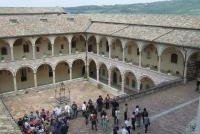
The train arrives at the village of Santa Maria dei Angeli, from where buses run to various points around Assisi. I alighted at Piazza Matteotti, the highest point, and close to the cathedral of San Rufino. Not an outstanding edifice with its austere exterior and drab interior.
From there I walked down to the Basilica of Santa Clara, a more interesting building, but plainly decorated inside.
My favourite however is the small church of Santa Maria of Minerva. The ornate altapiece is spectacular.
After passing through the town I descended to the Basilica of San Francisco. The frescoes here are amazing, and it was clear from the crowds here that most visitors never get to go beyond this building.
My last stop was the Abbey of St Peter's Monastery, an interestingly shaped building, before going to the bus stop in the Piazza dell'Unita d'Italia to catch a bus back to the station.
I made this visit on a day out from Rome.
Keep reading 0 comments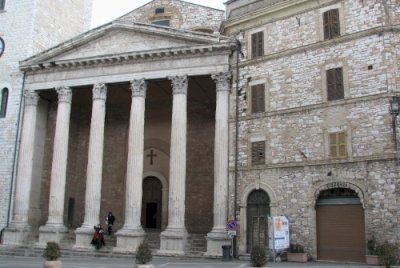
Assisi also has been built on a hill, the Asio. At its top lies the Rocca Maggiore fortress, below the town of about 25,000 inhabitants. All buildings are constructed in the same style and with the use of limestone.
This is really the busiest place so far on my journey. Besides Italian day-trippers, there are also buses full of schoolchildren, Polish and Chinese. Are they tourists or pilgrims? Assisi is a pilgrimage site because of Saint Francis. This poor little man founded a brotherhood focused on poverty, simplicity and charity. Nuns and monks are a common sight on the streets (clothed in gray, black and brown). But there are also plenty of souvenir shops to satisfy the tourist category.
I start my visit at the Santa Chiara Church. It is named after Clara, the companion of Francis. The ceiling of this church is completely painted with frescoes. Also, there are wooden crosses with images of Christ. In the very colorful crypt below stands her tomb. There are also relics to see of Clara (clothing and hair).
In the center of Assisi is the Piazza del Commune, the central square. It houses the Temple of Minerva from the 1st century BC. This was a Roman temple, but since the 13th century has become a church too. On the other side of the square is the town hall (Palazzo del Podesta) with frescoes on the ceiling over its gateway.
I finish my round at the St. Francis Basilica. …
Keep reading 0 comments
Assisi is a pretty touristy place, but justifiably so. The location on a hill is just amazing (especially coming from the west, i.e. Perugia), and the town itself is beautiful despite the crowds. Assisi is of course dominated by the Franciscan Order and its many churches, monasteries, and other structures, chief among them the huge Basilica of San Francesco on the edge of town, looking almost like a castle. Scattered on the outskirts of the town are nice places like the San Damiano Monastery, and the small town of Santa Maria degli Angeli with yet another very impressive church (after which, by the way, Los Angeles is named) is very close, too. An interesting place to visit, not only for pilgrims and monks.
Keep reading 0 comments
Ceramic tile was being removed from the floor in a large room in a building near the St. Francis’ Basilica. The workmen happily insisted we take a full piece of tile as a memento of Assisi. It’s right beside Jim’s computer, used every day as a coaster.
But surprise of all surprises, there was a two-story, canopy covered escalator, leading up the hill from the parking lot. At the top of the escalator we walked higher through the town, then turned and walked down, down and down the hill, snaking through this most unusual city. Fruit and vegetable vendors filled market squares, pink stone houses and stores lined the narrow walkways.
In spite of what we missed by not parking near the Basilica, parking in that upper lot, riding the escalator up the hill, then walking those miles down the hill through Assisi, was one of the best travel ideas we ever had even if it was just an accident.
From our book, Invitation To Italy (Google)
Keep reading 0 comments
